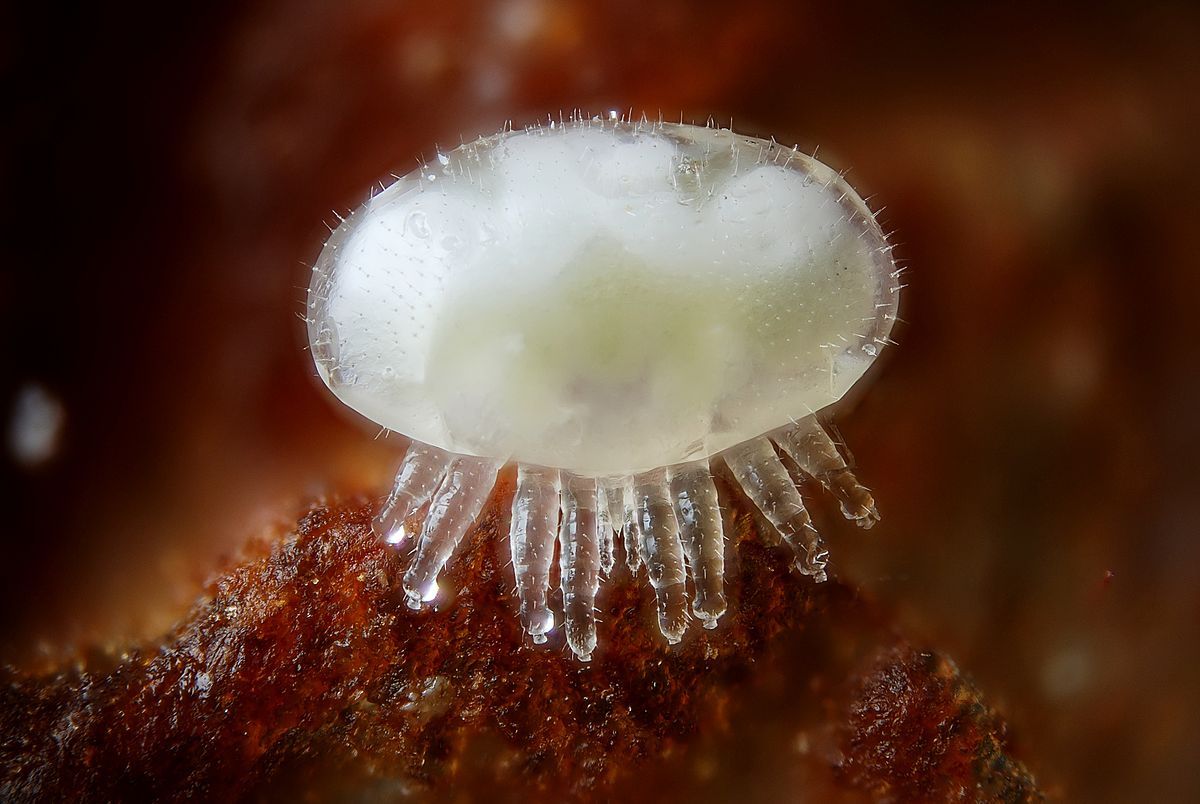«To defeat the bug, we must first understand the bug.»
Make no mistake, as custodians of bees and the environment, we are in a fight against the varroa mite. Gaining an understanding of the varroa mite is the first step in enabling us to determine the best cause of action for protecting the bees. In this article, we will examine some of the different stages of the varroa mite life cycle.
Life of a wanderer
The varroa mite has two stages- the first is the phoretic stage. During this stage, the varroa mite attaches to the abdomens of adult bees to feed on haemolymph and fat tissue from the intersegmental membrane. They also migrate horizontally to other colonies during this period, as bees rob, drift and forage. The phoretic stage sees a far higher mortality rate for mites, and usually lasts from 5 to 11 days when brood is present. However, during periods without brood or colder seasons, this stage can last up to 6 months. During summer and the height of the colonies size, only about 15 to 20 % of the varroa population are in the phoretic stage. The remainder are in the reproductive cycle, in capped brood cells.
Business time
The next stage is the reproductive stage. This stage accounts for around 80% of the mite population, depending on the season. As the name suggests, this is also when mites increase their population. Female varroa mites that have been mated with, enter the brood cells of both worker and drone brood before they are capped. Cells are capped around 10 days after eggs have been laid by the queen bee. Bees are known to partake in ‘hygenic’ behaviour and uncap cells that they know have varroa present. To counteract, the varroa mite has evolved to stay ahead of the curve, by hiding beneath the pupa (developing bee in the capped cell) and breathing from an appendage called a ‘peretrime’, which functions as a sort of ‘snorkel’. Five hours after the cell is capped, the female mite will begin feeding on the larvae. This weakens the pupa and exposes it to pathogens and viruses carried by mites. Within 70 hours, the soon-to-be mother mite lays her first egg, which becomes a male. Every 30 hours she lays more female eggs that then mate with the hatched male. 5 mite eggs can be laid in worker cells, while the larger drone cells provide a home for 6 eggs.

The weakened bees hatch from the brood cells 11 and 14 days after capping, for worker and drone bees respectively. The male mites and under-developed female mites become dehydrated and die upon uncapping, however the mated female mites leave the cell to continue the cycle. The daughter mites lay eggs after two weeks. Each female mite can complete three to four reproductive cycles.
Like a virus, mite infestation happens exponentially. The more brood present, the faster the rate of infestation. Areas with warmer climates and longer or constant brood periods will see more pronounced infestations, however even cooler climates have brood present for up to 8-10 months of the year.
The challenge for beekeepers is staying ahead of the game as the risk of ignoring varroa is more than likely colony loss within 2 to 4 years. By understanding the varroa life cycle as well as your own environmental variables, you are better equipped to make the right decisions.
The varroa life cycle and the effect on treatments
Miticides
Some varroacides only function when the mite is in the phoretic stage. As the miticide cannot penetrate wax cells of the drone brood, they do not affect mites that are already capped and reproducing.
These miticides require several brood cycles or up to 42 days to take effect on the entire mite population. To mitigate the differences in varroa life cycle and treatment duration, beekeepers sometimes opt for a 6 day cycle, where a treatment is reapplied every 6 days, over a period of three to four weeks. Here lies one of the limitations. Treatments are usually not recommended at such frequency due to the side effects they pose to brood and bees. Miticides are pesticides after all and even though mites are the target, they will deliver sublethal doses to bees. Even with repeat treatments though, these miticides cannot destroy the entire infestation or stop new mites entering the colony. This is referred to as ‘varroa leak’. As such, it is recommended never to rely on a single miticide as the only treatment type.
Some common miticides that fall into this group are:
-Oxalic acid
-Thymol
-Hops Beta acid
Drone Brood Removal
Due to longer post capping periods, mites have up to six times more reproductive success in drone brood than worker brood. Drone brood removal involves destroying the drone brood before it has the chance to emerge. And with it, the varroa. It must be said that while the mites have a preference, they will still infest worker brood. This treatment is viewed as a method of delaying infestation rather than removing it and while drone brood removal requires no chemicals, the cost is a sever amount of drone brood must be destroyed.
Heat treatment
Vatorex heating coils embedded in brood comb stop mite infestations at their source. By heating brood combs up to 42°, the varroa mites die while the brood and bees are unharmed. Treatments are automatically repeated every two weeks, and assure kill rates of 95% on each cycle. The cumulative effect is year-round reduced levels of varroa without the need for chemicals.
To learn more about varroa management, check out our free ebook: Your complete guide to the varroa mite.